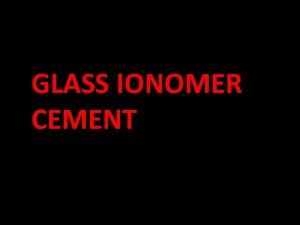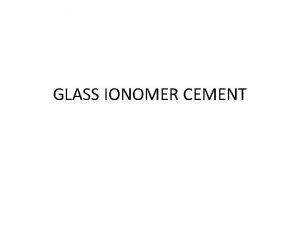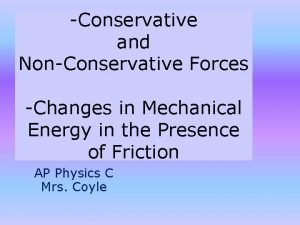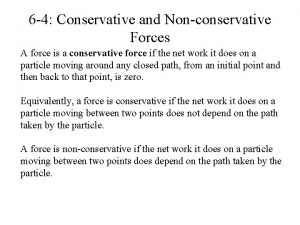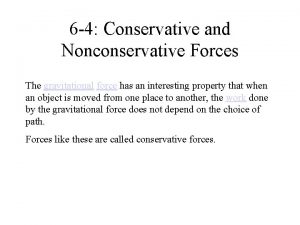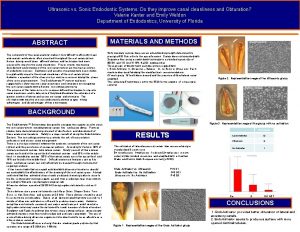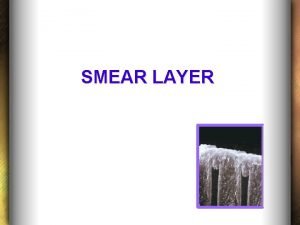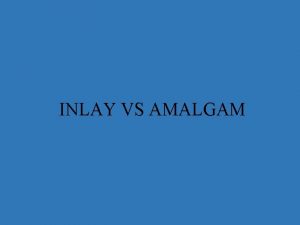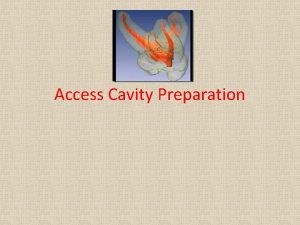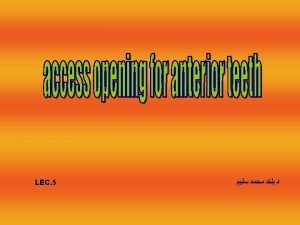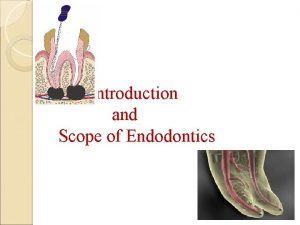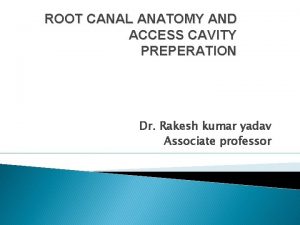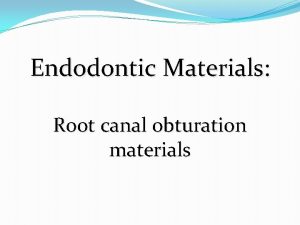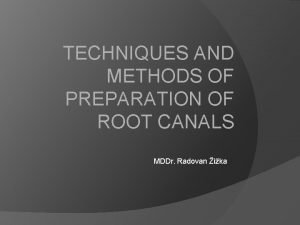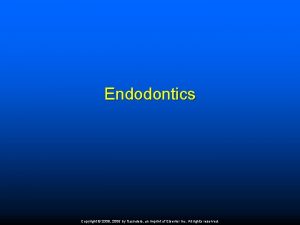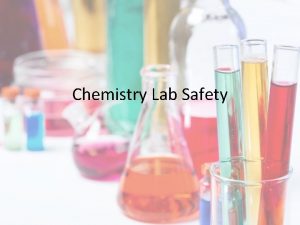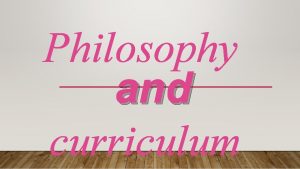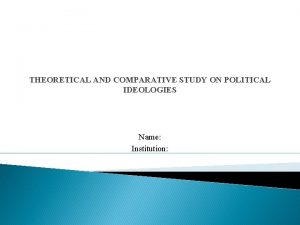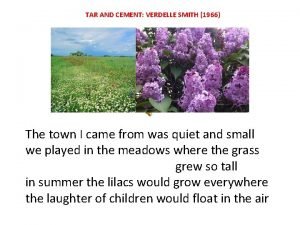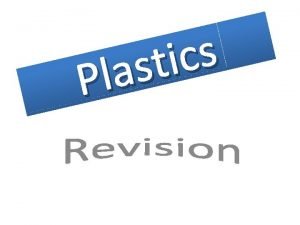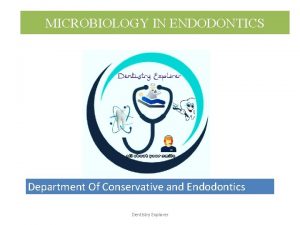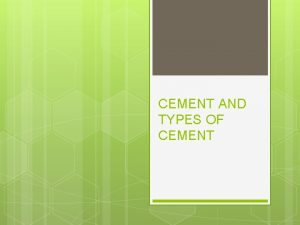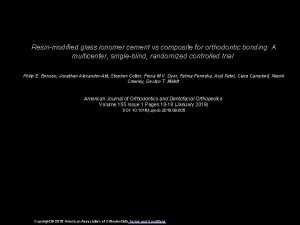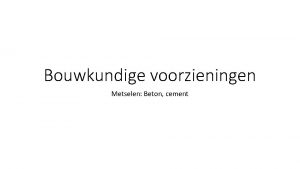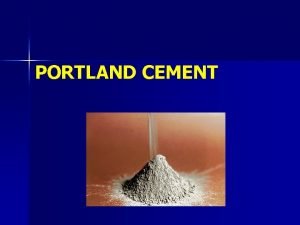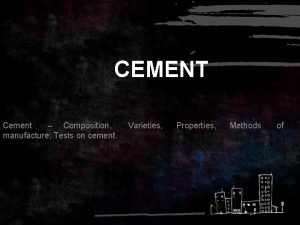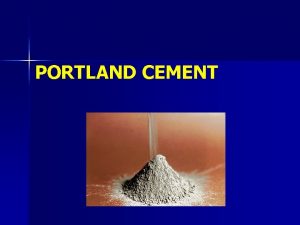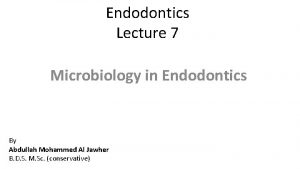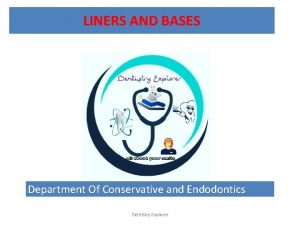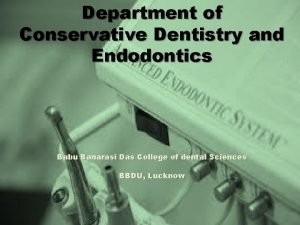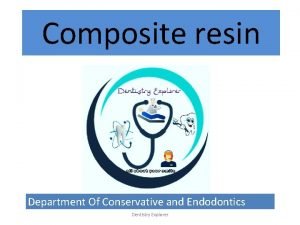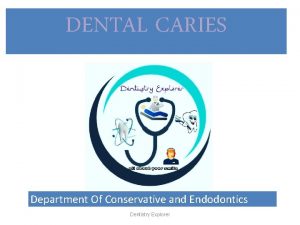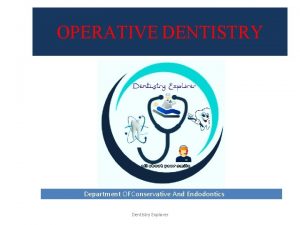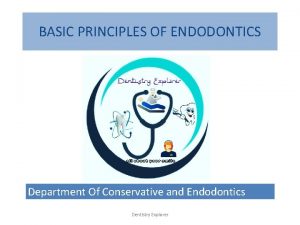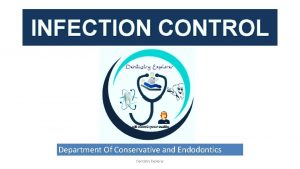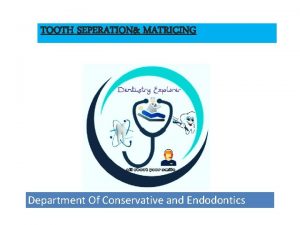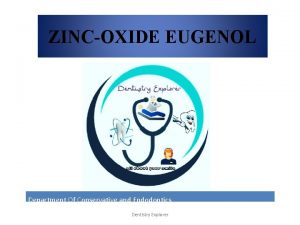Glass ionomer Cement Department Of Conservative and Endodontics


























- Slides: 26

Glass ionomer Cement Department Of Conservative and Endodontics Dentistry Explorer

INTRODUCTION Glass ionomer cement is a tooth coloured material, introduced by Wilson & Kent in 1972. Material was based on reaction between silicate glass powder & polyacrylic acid. They bond chemically to tooth structure & release fluoride for relatively long period. Dentistry Explorer

CLASSIFICATION Type I. II. For luting For restoration Type II. 1 Restorative esthetic Type II. 2 Restorative reinforced III. Type IV. Type VI. Type For liner & bases Fissure & sealent As Orthodontic cement For core build up Dentistry Explorer

COMPOSITION Powder : - Acid soluble calcium fluroalumino silicate glass. Silica - 41. 9% Alumina - 28. 6% Aluminum fluoride - 1. 6% Calcium fluoride - 15. 7% Sodium fluoride - 9. 3% Aluminum phosphate - 3. 8% Fluoride portion act as ceramic flux. Strontium, Barium or zinc oxide provide radio opacity. Dentistry Explorer

Liquid : 1. Polyacrylic acid in the form co-polymer with itaconic acid & malice acid. 2. Tartaric acid: improves handling characteristic & increase working time. 3. Water : Medium of reaction & hydrates the reaction products Dentistry Explorer

SETTING REACTION When the powder & liquid are mixed, Surface of glass particles are attacked by acid. then Ca, Al, sodium, & fluoride ions are leached into aqueous medium. Dentistry Explorer

ØCalcium poly salts are formed first, then followed by aluminum poly salts which cross link with poly anion chain. ØSet cement consist of unreacted powder particle surrounded by silica gel in amorphous matrix of hydrated calcium & aluminum poly salts. ØCalcium poly salts are responsible for initial set. ØAluminum poly salts form the dominant phase. Dentistry Explorer

Ø Water plays an important role in structure of cement. Ø After hardening, fresh cement is extremely prone to the cracking & crazing, due to drying of loosely bound water. Ø Hence these cements must be protected by application of varnish. Dentistry Explorer

SETTING TIME • Type II 4 - 5 minutes 7 minutes Dentistry Explorer

PROPERTIES • Compressive strength - 150 mpa • Tensile strength - 6. 6 mpa. • Hardness - 49 KHN. Dentistry Explorer

Solubility & Disintegration: • Initial solubility is high due to leaching of intermediate products. • The complete setting reaction takes place in 24 hrs, cement should be protected from saliva during this period. Dentistry Explorer

Adhesion : ☻Glass ionomer cement bonds chemically to the tooth structure. ☻Bonding is due to reaction occur between carboxyl group of poly acid & calcium of hydroxyl apatite. ☻Bonding with enamel is higher than that of dentin , due to greater inorganic content. Esthetics : GIC is tooth coloured material & available in different shades. Inferior to composites. They lack translucency & rough surface texture. Potential for discolouration & staining. Dentistry Explorer

Biocompatibilty : • Pulpal response to glass ionomer cement is favorable. • Pulpal response is mild due to - High buffering capacity of hydroxy apatite. - Large molecular weight of the polyacrylic acid , which prevents entry into dentinal tubules. Anticariogenic properties : • Fluoride is released from glass ionomer at the time of mixing & lies with in matrix. Fluoride can be released out without affecting the physical properties of cement. Dentistry Explorer

v. Initial release is high. But declines after 3 months. After this, fluoride release continuous for a long period. v. Fluoride can also be taken up into the cement during topical fluoride treatment and released again , thus GIC act as fluoride reservoir. Dentistry Explorer

MANIPULATION 1. Preparation of tooth surface : The enamel & dentin are first cleaned with pumice slurry followed by swabbing with polyacrylic acid for 5 sec. After conditioning & rinsing , tooth surface should isolate & dry. 2. Proportioning & mixing : Ø Powder & liquid ratio is 3: 1 bywt. Powder & liquid is dispensed just prior to mixing. Ø First increment is incorporated rapidly to produce a homogenous milky consistency. Ø Mixing done in folding method to preserves gel structure. Ø Finished mix should have a glossy surface. Dentistry Explorer

3. Protection of cement during setting : • Glass ionomer cement is extremely sensitive to air & water during setting. • Immediately after placement into cavity, preshaped matrix is applied to it. 4. Finishing : Ø Excess material should be trimmed from margins. Ø Hand instruments are preferred to rotary tools to avoid ditching. Ø Further finishing is done after 24 hrs. Dentistry Explorer

5. Protection of cement after setting : • Before dismissing the patient , restoration is again coated with the protective agent to protect trimmed area. • Failure to protect for first 24 hrs results in weaken cement. Dentistry Explorer

Advantages: ♣ Inherent adhesion to the tooth surface. ♣ Good marginal seal. ♣ Anticariogenic property. ♣ Biocompatibilty ♣ Minimal cavity preparation required. Disadvantages: ♦ ♦ Low fracture resistance. Low wear resistance. Water sensitive during setting phase. Less esthetic compared to composite. Dentistry Explorer

Uses : 1. Anterior esthetic restoration material for class III & V restorations. 2. For luting. 3. For core build up. 4. For eroded area. 5. For atraumatic restorative treatment. 6. As an orthodontic bracket adhesive. 7. As restoration for deciduous teeth. 8. Used in lamination/ Sandwich technique. Dentistry Explorer

SANDWICH TECHNIQUE ØDevolped by Mclean, ØTo combine the beneficial properties of GIC & composite. Dentistry Explorer

Clinical steps: ØAfter cavity preparation, condition the cavity to develop good adhesion with GIC. ØPlace Type III GIC into prepared cavity. ØAfter setting, etch the enamel & GIC with orthophosphoric acid for 15 ØApply a thin layer of low viscosity enamel bonding seconds. agent & finally place the ØThis will improve micromechanical bond to composite resin over GIC & light cure it. composite resin. Dentistry Explorer

ADVANTAGES: ♣ Polymerisation shrinkage is less, due to reduced bulk of composite. ♣ Favorable pulpal response. ♣ Chemical bond to the tooth. ♣ Anticariogenic property. ♣ Better strength, finishing, esthetics of overlying composite resin. Dentistry Explorer

MODIFICATIONS 1. Water settable glass ionomer cement : • Liquid is delivered in a freeze dried form , which is incorporated into the powder. • Liquid used is clean water. 2. Resin modified glass ionomer cement : Powder component consist of ion leachable fluroalumino silicate glass particles & initator for light curing. Liquid component consist of water & poly acrylic acid with methacrylate & hydroxyl ethyl methacrylate monomer. Dentistry Explorer

3. Metal modified glass ionomer cement: • Glass ionomer have been modified by addition of filler particles , to improve strength , fracture toughness & resistance to wear. Silver alloy admix / miracle mix: • This is made by mixing of spherical silver amalgam alloy powder with glass ionomer powder. Cerment: • Bonding of silver particles to glass ionomer particles by fusion through high temperature sintering. Dentistry Explorer

4. Compomer : Compomer is a composite resin that uses an ionomer glass which is the major component of glass ionomer as the filler. Small quantity of dehydrated polyalkenoic acid incorporated with filler particles, Setting reaction is light activated. Adhesive system used with compomer is based on acid etch found with all composite resin. Dentistry Explorer

Thank You Dentistry Explorer
 Gic composition
Gic composition Types of gic in dentistry
Types of gic in dentistry Work done by conservative force
Work done by conservative force Force conservative et non conservative
Force conservative et non conservative Force conservative et non conservative
Force conservative et non conservative Gravitational force is conservative
Gravitational force is conservative Ultrasonic vs sonic
Ultrasonic vs sonic Smear layer definicion
Smear layer definicion Inlay cavity walls
Inlay cavity walls Access opening definition in endodontics
Access opening definition in endodontics Lingual surface
Lingual surface Endodontics definition grossman
Endodontics definition grossman Creekside endodontics
Creekside endodontics Krasner and rankow law of access opening
Krasner and rankow law of access opening Sargenti sealer composition
Sargenti sealer composition Classification of obturating materials
Classification of obturating materials Coronal flaring in endodontics
Coronal flaring in endodontics Chapter 54 endodontics
Chapter 54 endodontics What is the glass escalator
What is the glass escalator If an acid is splashed on your skin, wash at once with
If an acid is splashed on your skin, wash at once with Does hot glass look like cold glass
Does hot glass look like cold glass Perennialism characteristics
Perennialism characteristics Physics 03-06 impulse and momentum answer key
Physics 03-06 impulse and momentum answer key Conservative comparative and superlative
Conservative comparative and superlative Conservative policies under reagan and bush
Conservative policies under reagan and bush Tar and cement
Tar and cement Tensol cement advantages
Tensol cement advantages
